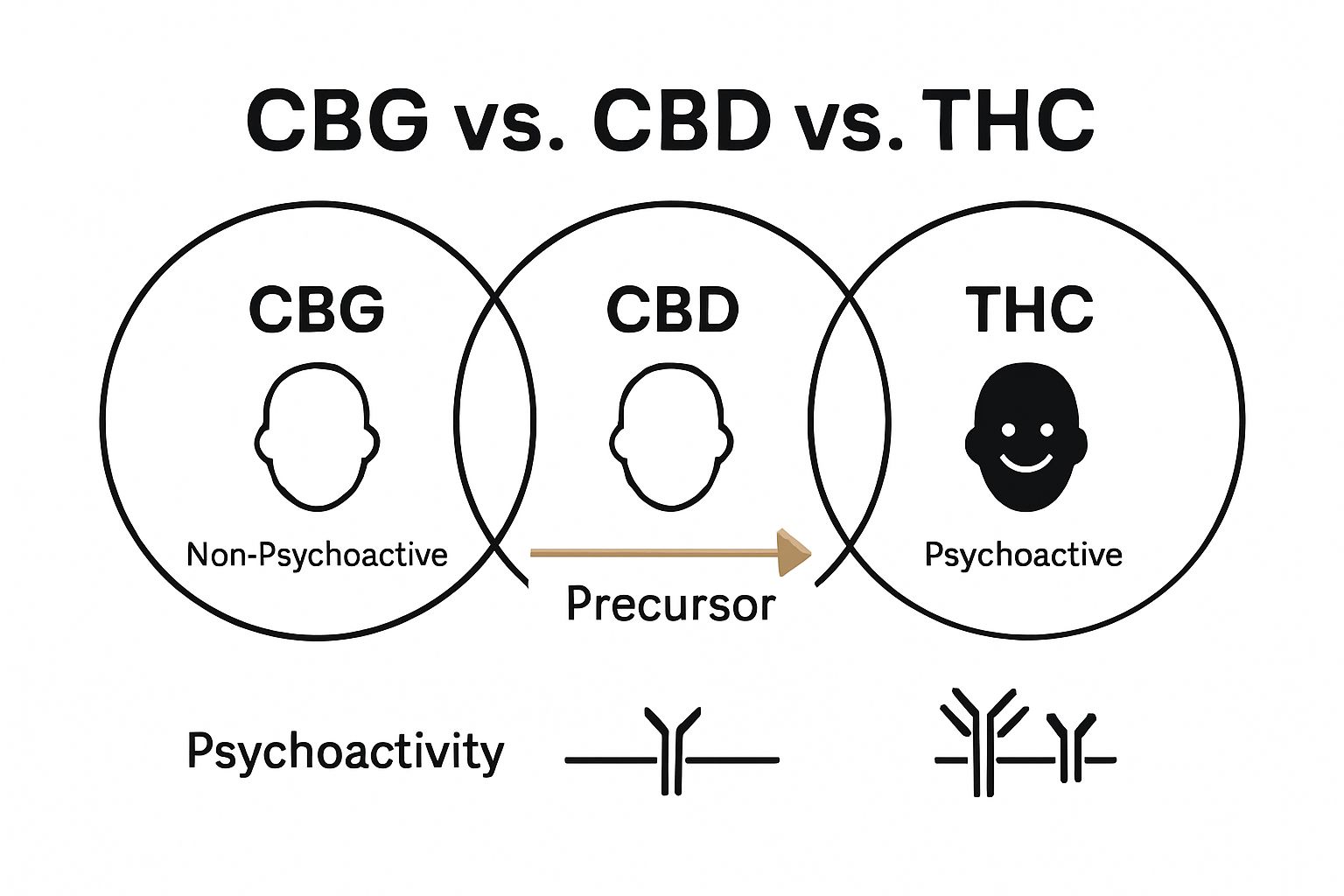What is CBG Flower? Understanding its Benefits and Uses
Written by Trevor

CBG has caught the attention of researchers for its impressive role as the “mother of all cannabinoids” in cannabis. Most people focus on THC or CBD, thinking those are the real stars. But CBG actually forms the base for all other major cannabinoids and does not get you high at all. This opens the door to benefits that might surprise you and sparks a whole new way to look at cannabis wellness.
Table of Contents
- Understanding Cbg: The Basics Of Cannabigerol
- The Importance Of Cbg Flower In The Cannabis Family
- How Cbg Works: Interactions With The Endocannabinoid System
- Comparing Cbg With Other Cannabinoids: A Closer Look
- Potential Benefits And Applications Of Cbg Flower
Quick Summary
| Takeaway | Explanation |
|---|---|
| CBG is a non-psychoactive cannabinoid | Unlike THC, CBG does not produce a high, making it suitable for wellness applications. |
| CBG plays a foundational role in cannabis | It is known as the “mother of all cannabinoids,” essential for the development of others. |
| CBG interacts with the endocannabinoid system | It modulates receptor activity, offering potential therapeutic benefits without psychoactive effects. |
| CBG flower has unique wellness benefits | This specialized flower retains higher CBG concentrations, allowing for targeted therapeutic exploration. |
| Research supports various health applications of CBG | Early studies suggest CBG may assist with neurological health, inflammation, and stress management. |
Understanding CBG: The Basics of Cannabigerol
Cannabinoids have become increasingly fascinating in wellness research, and cannabigerol (CBG) represents a groundbreaking compound with remarkable potential. Research indicates that CBG is a unique non-psychoactive cannabinoid found in Cannabis sativa, distinguished by its remarkable biochemical properties.
The Chemical Origin of CBG
Often referred to as the “mother of all cannabinoids,” CBG serves as a fundamental chemical precursor in cannabis plant development. Unlike THC or CBD, CBG exists in its original acidic form during early plant growth stages. As the cannabis plant matures, enzymes transform CBG into other cannabinoids, making it a critical foundational compound in the cannabinoid spectrum.
How CBG Interacts with the Body
CBG interacts directly with the human endocannabinoid system, engaging with CB1 and CB2 receptors throughout the body. This interaction suggests potential therapeutic applications across multiple physiological systems. Key areas of potential CBG interaction include:
- Neurological function and brain health
- Inflammatory response modulation
- Potential neuroprotective mechanisms
- Potential mood and stress regulation
Emerging scientific studies suggest that CBG might offer unique wellness benefits distinct from other cannabinoids. Researchers are increasingly interested in understanding its specific mechanisms and potential applications.
For those curious about exploring alternative cannabinoids, our comprehensive guide on cannabinoid exploration provides deeper insights into this fascinating field of research.
The Importance of CBG Flower in the Cannabis Family
CBG flower represents a groundbreaking development in cannabis cultivation, highlighting the growing sophistication of genetic breeding and cannabinoid research. Scientists have discovered that modern agricultural techniques now allow for targeted production of cannabinoid-specific plants, enabling researchers and consumers to explore CBG’s unique properties more comprehensively.
Genetic Significance of CBG
Unlike traditional cannabis varieties that quickly convert CBG into other cannabinoids, specialized CBG flower maintains higher concentrations of this foundational compound. This genetic innovation allows for more direct exploration of CBG’s potential therapeutic properties. The ability to preserve CBG in its original form represents a significant advancement in cannabis breeding, offering researchers and wellness enthusiasts unprecedented access to this remarkable cannabinoid.
Potential Wellness Applications
CBG flower distinguishes itself through potential wellness benefits that differ from more commonly known cannabinoids. Emerging research suggests CBG might offer unique interactions with the human body, potentially supporting various physiological processes. Key potential areas of CBG flower’s impact include:
- Neurological system support
- Potential anti-inflammatory responses
- Mood and stress management
- Potential immune system modulation
These potential applications underscore why CBG flower has become increasingly important in the cannabis research ecosystem. Researchers are particularly interested in understanding how CBG’s molecular structure enables these distinctive interactions.
Learn more about alternative cannabinoids and discover the fascinating world of cannabis research that extends far beyond traditional CBD and THC narratives.
How CBG Works: Interactions with the Endocannabinoid System
The endocannabinoid system represents a complex network of cellular communication that plays a critical role in maintaining physiological balance. Research demonstrates that CBG interacts uniquely with this system, engaging both CB1 and CB2 receptors through intricate molecular mechanisms that differ from other cannabinoids.
Receptor Engagement and Molecular Interactions
CBG operates as a nuanced molecular agent within the endocannabinoid system. Unlike THC, which directly activates receptors, CBG functions more subtly by modulating receptor activity. This distinctive interaction suggests potential therapeutic applications without the psychoactive effects associated with other cannabinoids. The compound’s ability to bind to receptors without full activation creates a complex biochemical dialogue that researchers find increasingly fascinating.
Physiological Impact Mechanisms
The interactions between CBG and the endocannabinoid system extend beyond simple receptor binding. Key physiological processes potentially influenced by CBG include:
- Neurotransmitter regulation
- Inflammatory response modulation
- Potential neuroprotective signaling
- Cellular homeostasis maintenance
- Immune system communication
CBG’s molecular structure allows for sophisticated cellular communication, enabling potential wellness benefits that distinguish it from other cannabinoids. Its partial agonist properties suggest a more nuanced approach to supporting bodily systems.

Explore our detailed guide on cannabinoid receptor interactions to gain deeper insights into the complex world of endocannabinoid system functioning.
Comparing CBG with Other Cannabinoids: A Closer Look
Cannabinoids represent a diverse family of chemical compounds, each with unique molecular characteristics and potential interactions within the human body. Scientific research reveals that CBG distinguishes itself through remarkable properties that set it apart from more well-known cannabinoids like THC and CBD.
Distinctive Molecular Characteristics
While THC is known for its psychoactive effects and CBD for its widespread wellness applications, CBG emerges as a fundamentally different compound. CBG is non-psychoactive, meaning it does not produce the euphoric “high” associated with THC. Its molecular structure allows for subtle interactions with the endocannabinoid system, creating a unique biochemical profile that intrigues researchers and wellness enthusiasts alike.
Comparative Interaction Mechanisms
Each cannabinoid interacts with the human body’s systems differently. Key distinctions between CBG and other cannabinoids include:
- Non-psychoactive molecular structure
- More nuanced receptor engagement
- Potential for targeted physiological support
- Different metabolic pathways
- Unique inflammatory response modulation
CBG’s potential lies in its ability to interact with biological systems without the intense effects of THC, offering a more balanced approach to cannabinoid wellness.
To help clarify the differences between CBG, CBD, and THC, the following table compares their core molecular characteristics, effects, and interactions as described in the article.
| Cannabinoid | Psychoactive? | Primary Molecular Role | Notable Effects/Interactions |
|---|---|---|---|
| CBG | No | “Mother of all cannabinoids”; precursor | Modulates endocannabinoid receptors without high; supports neurological, anti-inflammatory, and stress-regulation pathways |
| CBD | No | Derived from CBG via plant enzymes | Widely applicable for wellness; modulates inflammation and stress; not psychoactive |
| THC | Yes | Major cannabinoid formed from CBG | Produces euphoric “high”; directly activates CB1 receptor; intense psychoactive effects |

Learn more about the intricate world of phytocannabinoids and explore the fascinating scientific landscape of these remarkable compounds.
Potential Benefits and Applications of CBG Flower
CBG flower represents an emerging frontier in wellness research, offering potential therapeutic applications that extend across multiple physiological systems. Preclinical studies suggest that CBG demonstrates remarkable versatility in addressing various health challenges through its distinctive molecular interactions.
Therapeutic Potential Across Health Domains
Researchers are increasingly exploring CBG’s potential in addressing complex health conditions. Unlike traditional pharmaceutical approaches, CBG offers a nuanced mechanism of action that could provide holistic support for multiple bodily systems. Its unique molecular structure enables targeted interactions that distinguish it from other cannabinoids, creating exciting possibilities for wellness interventions.
The following table summarizes the physiological systems and potential wellness benefits that CBG flower may support, based on information discussed across the article.
| Physiological System / Function | Potential Benefit of CBG Flower |
|---|---|
| Neurological System | Supports brain health; possible neuroprotection |
| Inflammatory Response | May modulate inflammation; anti-inflammatory support |
| Mood and Stress Regulation | Possible stress management and mood balance |
| Immune System | Potential immune modulation |
| Gastrointestinal System | Possible regulation and support |
| Antibacterial Potential | Shows possible antibacterial properties |
Potential Clinical Applications
The emerging research on CBG flower highlights several promising areas of potential therapeutic benefit:
- Neurological system support
- Potential inflammatory response modulation
- Gastrointestinal system regulation
- Potential antibacterial properties
- Mood and stress management mechanisms
CBG’s sophisticated biochemical profile suggests profound potential for targeted wellness support. While research remains ongoing, early investigations indicate that CBG might offer a more balanced and comprehensive approach to supporting physiological functions compared to isolated cannabinoid treatments.
Discover more about cannabinoid wellness strategies and explore the cutting-edge landscape of natural health solutions.
Experience the Difference with Premium CBG Flower at California Blendz
If you are excited about the natural benefits and unique interactions of CBG flower, you probably want a trustworthy source that offers more than just promises. Many consumers struggle to find truly organic, lab-tested CBG options that genuinely support relaxation, focus, or wellness goals. When purity, transparency, and effect matter, you deserve more than ordinary blends. At The Founder’s Collection – California Blendz, you will discover hand-selected CBG and hemp-derived flowers grown sustainably in the Emerald Triangle. Every batch is thoroughly tested and carefully curated to bring out the best of what CBG can offer.

Ready to explore authentic, high-quality CBG for your personal wellness? Visit California Blendz now to experience next-level cannabinoid products with full transparency and fast shipping across the U.S. Learn more about calming blends and flower options designed for everyday relief by visiting Bliss Blendz. Take control of your wellness journey today and choose products crafted with care and expertise.
Frequently Asked Questions
What is CBG flower and how is it different from other cannabis flowers?
CBG flower is a type of cannabis flower that contains a high concentration of cannabigerol (CBG), a non-psychoactive cannabinoid. Unlike traditional cannabis flowers that convert CBG into THC or CBD, CBG flowers preserve this foundational compound for targeted therapeutic exploration.
What potential benefits does CBG flower offer?
CBG flower may support various health aspects, including neurological function, anti-inflammatory responses, and stress management. To explore these benefits, consider incorporating CBG flower as part of your wellness routine to assess individual effects.
How does CBG flower interact with the endocannabinoid system?
CBG flower engages with the endocannabinoid system by modulating the activity of CB1 and CB2 receptors without producing the high associated with THC. Understanding this interaction can inform users on how to harness its potential benefits effectively.
What are some practical ways to use CBG flower?
CBG flower can be consumed through various methods, such as vaping, smoking, or infusing into oils. Experiment with different methods to find the one that best suits your preferences and desired effects.
Are there any side effects associated with using CBG flower?
While CBG is generally considered safe and non-psychoactive, some users may experience mild side effects such as fatigue or dizziness. Monitor your body’s reactions and consult with a healthcare professional if you experience any concerning symptoms after use.
How can I learn more about CBG flower and its applications?
To explore CBG flower further, review emerging research and studies focusing on its therapeutic potential and uses. Regularly check scientific literature to stay updated about innovations in cannabinoid research.








